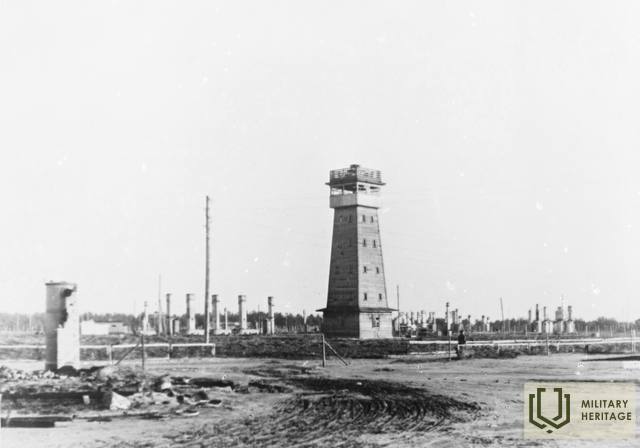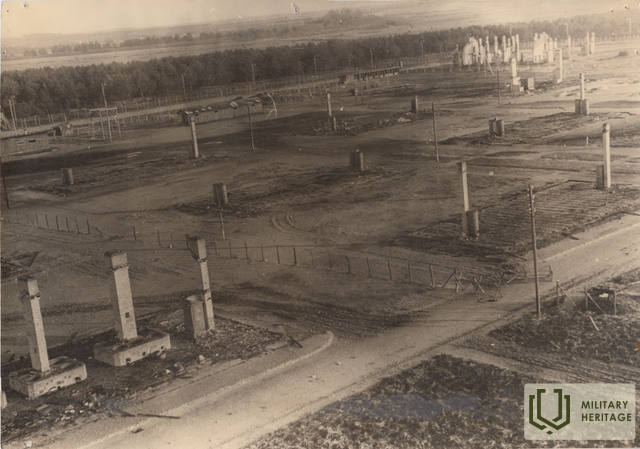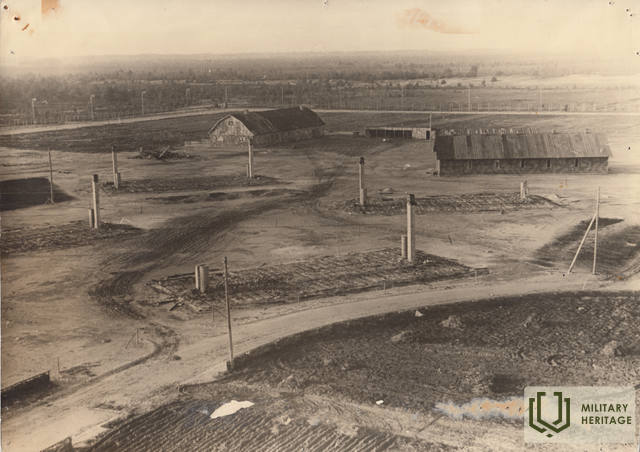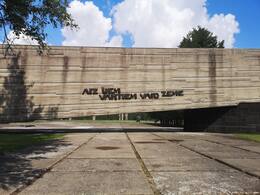Apie Salaspilio memorialą kaip sovietinio okupacinio režimo ideologijos simbolį.
Aprašyme vaizdžiai aprašomas memorialinės vietos politizavimo mastas ir jos vaidmuo Sovietų Sąjungos ideologijoje. Tekste minima, kad vienas iš pagrindinių tikslų – kova su „fašizmo atgimimu“. Tai rodo, kad ideologinė infrastruktūra ir toliau naudojama komunistų nusikaltimams slėpti ir kitaip mąstančiųjų nuomonei uždrausti. Memorialinės vietos, sovietų armijos kapinės ir muziejai, įvairūs kultūriniai renginiai palaikė „Latvijos išvadavimo“ ir „broliškos Sovietų Sąjungos“ mitą. Nacių nusikaltimų faktai buvo panaudoti kuriant iškreiptą Antrojo pasaulinio karo įvykių Latvijoje vaizdą.
„(..) Kiekvienais metais Salaspilio ansamblis rengia vokiškojo fašizmo aukų atminimo dieną „Negalima pamiršti“.“ Jau tapo tradicija, kad ši diena su dideliu mitingu visada vyksta liepą – sekmadienį prieš Sovietų Latvijos įkūrimo metines. Tuomet Salaspilyje susirenka tūkstančiai darbininkų ir buvusių kalinių. Pastarieji į ansamblio teritoriją atvyksta porą valandų prieš mitingą. Jie turi daug ką aptarti tarpusavyje. Matomi draugiški, jaudinantys susitikimai, nes buvę kovos draugai atvyko ne tik iš visų respublikos regionų, bet net iš Maskvos, Leningrado, Baltarusijos ir Lietuvos. Kiekvienais metais registruojami buvę kaliniai, tikrinami jų adresai ir atliekama apklausa, ar kas nors sužinojo ką nors apie dingusius bendražygius, kurių giminaičiai vis dar ieško. Visa tai organizuoja ir vykdo buvusių politinių kalinių grupės, veikiančios prie Sovietų Sąjungos, biuras. Karo veteranų komiteto Rygos skyrius. Šiuo metu grupėje užregistruota 500 buvusių kalinių. Grupės nariai pagrindine savo užduotimi laiko kovą su fašizmo atgimimu. Jie dažnai susitinka su moksleiviais, įmonių ir įstaigų darbuotojais, kaimo žmonėmis, veda ekskursijas po Salaspilio teritoriją, ir rinkti medžiagas Salaspilio ansamblio muziejui. Už aktyvią antifašistinę veiklą grupės nariams prieš mitingą įteikiami Sovietų Sąjungos karo veteranų komiteto garbės raštai ir krūtinės šarvai. Prasideda iškilminga akimirka – žygis į Salaspilio ansamblio iškilmių aikštę, kur vyksta mitingas. Buvę kaliniai su vainikais stovi kolonų priekyje. Groja laidotuvių muzika. Mitingą pradeda tylos minute, kuria pagerbiami 100 000 Salaspilyje nužudytų žmonių. Pirmasis kalba buvusių kalinių atstovas. Jis kalba apie fašistų Salaspilyje įvykdytus nusikaltimus ir savo narių vardu pažada visas jėgas skirti taikos reikalui. Kalba darbininkų, kareivių ir komjaunimo narių atstovai. Groja muzika, dainuoja choras, aktoriai deklamuoja eilėraščius. Mitingo pabaigoje padedamos gėlės ir vainikai. Atrodo, kad Salaspilis pamažu skęsta gėlėse. Visi mitingo dalyviai eina pro gėlių kalvas, tyliai linkėdami, kad mūsų ateities kartos... daugiau niekada nepatirs karo siaubų.(..)
Testo ištrauka paimta iš sovietinės okupacijos laikų leidinio „Salaspilio mirties stovykla“ (1973 m.). Teksto autorius nežinomas.
Susijusi laiko juosta
Susijusios temos
Susijusios vietos
Salaspilio memorialinis ansamblis
Salaspilio memorialas ir istorinė ekspozicija yra Salaspilio savivaldybėje, 1,2 km nuo Rygos–Daugpilio greitkelio A6. Salaspilio memorialas buvo atidengtas 1967 m. toje vietoje, kur Antrojo pasaulinio karo metu buvo įsikūrusi Salaspilio stovykla. Tai vieta, kuri buvo naudojama sovietinei propagandai ir yra apipinta mitais bei pusinėmis tiesomis. Tai geras nacių nusikaltimų ir komunistinės ideologijos, vykdytos kiekvienos okupacijos metu, atvaizdas. Ši represinė stovykla buvo Vokietijos pataisos sistemos dalis. Ji turėjo panašumų su koncentracijos stovyklomis, bet tai nebuvo tas pats. Ji buvo sukurta tam, kad Rygos kalėjimuose nebūtų neproporcingai daug kalinių. Ši stovykla buvo „policijos kalėjimo tęsinys“. Čia buvo kalinami įvairūs žmonės – žydai, Raudonosios armijos karo belaisviai, pravaikštos dalyviai, politiniai kaliniai, nusikaltėliai, prostitutės, Latvijos pasipriešinimo judėjimo nariai, Baltijos šalių kareiviai Vokietijos armijoje ar policijoje ir kiti. Stovykloje galėjo kalėti iki 2200 kalinių. Pagrindinė mirties priežastis (apie 2000 m.) buvo nepakankama mityba, darbo sąlygos, fizinės bausmės ir ligos.








